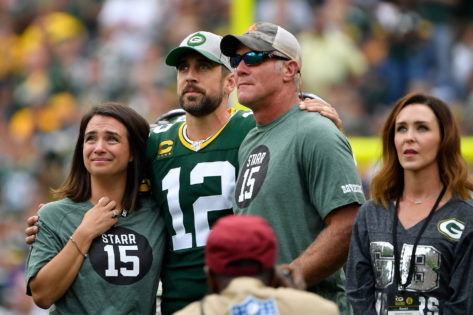What happens to a team’s heartbeat when living legends hang in the balance? “That saga of Brett retiring and unretiring, back and forth, was one of the craziest of that era,” recalled NFL executive Tim Terry, whose first Green Bay draft pick, no pressure, just happened to be Aaron Rodgers. Imagine making your front-office debut in a city where fans schedule family vacations just to watch quarterbacks at practice, and suddenly every bike parade to Lambeau Field is a referendum on the future of the franchise.
In Green Bay, quarterbacks aren’t just starters; they’re icons, celebrities, and at times, symbols of division. The move from Brett Favre, the ironman with a record 299 consecutive starts, to a California kid who spent three seasons clipboard-in-hand, was measured in more than jersey sales. Fans were torn. “That was the first time I saw where there was fans divided,” Terry reminisced: one camp furiously defending Favre, the other shouting for Rodgers, and everyone a bit mad at the front office. As Favre waffled on retirement, then pressed ‘undo’ again, the organizational stress test was relentless. It wasn’t just about who got QB1 reps. It was about legacy and uncertainty, about not letting the moment or the backlash overwhelm good football sense.
The true impact of Favre’s actions didn’t just shape a hot-off-the-bench Rodgers, they fundamentally forged his resilience. “It can tax you a little bit as far as your planning,” Terry revealed of the annual will-he-or-won’t-he tension. But patience, he said, became his greatest teacher. For Rodgers, the toll was internal: faced with not just the weight of Favre’s shadow but his abrupt returns, every practice snap and press conference marinated in speculation. “I couldn’t imagine being in his shoes, some of the pressures he faced as a young quarterback just trying to play ball,” Terry admitted. Rodgers’ response? “He handled it like a pro should.” The messy public divorce between Favre and Green Bay was, by all accounts, a crucible, one in which Rodgers’ calm under fire grew legendary, setting up a career of ice-cold precision in high-pressure moments.
Aaron #Rodgers runs over to Brett #Favre after jersey retirement… and they embrace. pic.twitter.com/EvK6mS9clB
— Elise Menaker (@EliseMenaker) November 27, 2015
Terry credits then-GM Ted Thompson’s “steadfastness and prudency” for holding the line under intense backlash, focusing not on sentiment but on “what was best for the organization.” To Green Bay’s credit, the franchise didn’t yield to short-term emotion. Favre, denied his preferred divisional reunion, was dealt to the Jets and then finished his career with the Vikings. Rodgers, meanwhile, grabbed the reins in 2008 and didn’t just run the offense, he rewrote franchise history: four-time MVP, Super Bowl champion, a TD-INT ratio for the ages. That patience, says Terry, “worked out for both sides.”
Brett Favre’s exit and Aaron Rodgers’ rise split Green Bay fans down the middle
The Favre-to-Rodgers transition didn’t just reshuffle the quarterback depth chart; it cracked open a generational fault line among Packer Nation. “There was a lot of heat not on me directly but just from the outside, the media, the fan base, one way or the other,” Terry reflected. That summer, Green Bay became a microcosm of NFL tribalism, with buses of cheeseheads chanting for opposite heroes at every open practice, every Lambeau tailgate and Titletown tavern.
For many, the public split felt personal. When Favre ultimately landed in Minnesota, facing Green Bay twice a year, emotional stakes hit a fever pitch. It was once reported that fans would split jerseys with Favre’s number on the front and with Rodgers’ on the back. That perhaps was a walking identity crisis. It was the kind of friction that could have paralyzed a franchise or, conversely, galvanized a new era.
The ultimate proof? Aaron Rodgers, who is currently struggling, not only endured but thrived in the firestorm. After an up-and-down debut season, he led Green Bay to a Super Bowl title just three years after Favre’s departure. “Stepping into that role under those circumstances, it forged him,” says Terry. “He grew stronger from it.” In the aftermath, Green Bay fans, once split, eventually found common ground, not because the pain of change faded, but because Rodgers carved out his own indelible legacy.
August 7, 2016 – Canton, Ohio, United States – (L-R) Green Bay Packers quarterback Brett Hundley (7), quarterback Marquis Williams (9), quarterback Aaron Rodgers (12) and quarterback Joe Callahan (6) before the NFL American Football Herren USA Hall of Fame Game against the Indianapolis Colts. The game was cancelled due to poor field conditions at Tom Benson Hall of Fame Stadium. NFL 2016: Hall of Fame Game – Green Bay Packers vs Indianapolis Colts – ZUMAw109 | Reuters
If there’s a metaphor for this transition, it’s the Green Bay winter: long, bitter, but ultimately giving way to new life each spring. For both Favre and Rodgers, the story is less about a clean handoff and more about the iron sharpens iron reality of NFL succession, pressure forging greatness, scars included. The question in Green Bay now isn’t just who’s next at quarterback, but whether another legend-in-waiting can weather the noise and write the next chapter under that storied Lambeau sky.
The post NFL Exec, Who Drafted Aaron Rodgers, Reveals How Brett Favre’s Actions Effected Packers Legend appeared first on EssentiallySports.
